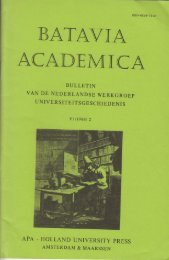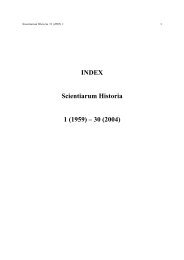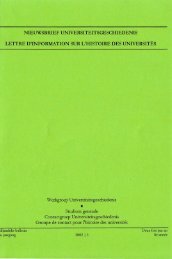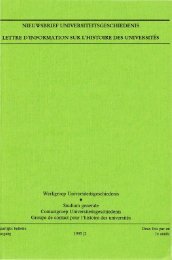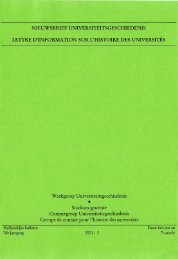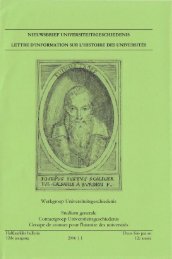the ocular harpsichord of louis-bertrand castel - Gewina
the ocular harpsichord of louis-bertrand castel - Gewina
the ocular harpsichord of louis-bertrand castel - Gewina
Create successful ePaper yourself
Turn your PDF publications into a flip-book with our unique Google optimized e-Paper software.
70 Maarten Franssen<br />
perience, to communicate to those who have a taste for this kind <strong>of</strong> beauty, a pleasure as<br />
intense and as permanent as that which <strong>the</strong> finest ear derives from musical sounds.'*^<br />
In France, on <strong>the</strong> o<strong>the</strong>r hand, Castel's name was already completely forgotten at<br />
<strong>the</strong> begiiming <strong>of</strong> <strong>the</strong> 19th century. In his review <strong>of</strong> <strong>the</strong> Salon <strong>of</strong> 1846, Baudelaire<br />
suddenly argued for an analogy between colours and sounds, in apparently<br />
complete ignorance <strong>of</strong> its history. In fact, he almost sounded like Castel reincarnated:<br />
"In colour <strong>the</strong>re are harmony, melody and counterpoint to be found ...<br />
Harmony is <strong>the</strong> basis <strong>of</strong> <strong>the</strong> <strong>the</strong>ory <strong>of</strong> colour. Melody is <strong>the</strong> unity in colour, or<br />
coloiu" in general ... The colorists design from nature; <strong>the</strong>ir figures are naturally<br />
delimited by <strong>the</strong> harmonious struggle <strong>of</strong> harmonious masses," and he ended<br />
with: "I do not know whe<strong>the</strong>r any analogist has ever solidly established a<br />
complete scale <strong>of</strong> colours and feelings ..."'"*<br />
During <strong>the</strong> 19th century nothing more was said on <strong>the</strong> subject except by one<br />
or two isolated figures, until, from about <strong>the</strong> last decades <strong>of</strong> <strong>the</strong> 19th century,<br />
<strong>the</strong>re suddenly emerged an enormous interest in <strong>the</strong> psychological phenomenon<br />
<strong>of</strong> synaes<strong>the</strong>sia. Weliek has listed some 800 titles on this subject for <strong>the</strong> period<br />
1880-1931.'"^ The phenomenon was considered a purely psychological one, a<br />
kind <strong>of</strong> automatic association <strong>of</strong> certain colours with certain sounds or smells, or<br />
combinations <strong>of</strong> such, which people reported actually to experience. There was<br />
no connection at all with <strong>the</strong> eighteenth-century discussion on colour music. In<br />
fact, <strong>the</strong> phenomenon <strong>of</strong> synaes<strong>the</strong>sia is hardly reported before <strong>the</strong> period it was<br />
so extensively studied. One <strong>of</strong> <strong>the</strong> first instances is a fragment <strong>of</strong> E.TA. H<strong>of</strong>fmaim<br />
from 1814, in which he confessed to experience in <strong>the</strong><br />
state <strong>of</strong> delirium that immediately precedes falling asleep, especially when I have listened a lot<br />
to music, an analogy <strong>of</strong> colours, tones and scents ... The smell <strong>of</strong> <strong>the</strong> dark red carnation has a<br />
strange magical force on me; inadvertently I sink into a dreamlike state and I hear, coming<br />
Brewster, Treatise, pp. 131, 134-135. The 200.000 copies are mentioned on p. 7. Note,<br />
moreover, with an eye on <strong>the</strong> <strong>the</strong>ses <strong>of</strong> Neubauer and Barry, that Brewster's kaleidoscope did not<br />
show <strong>the</strong> abstract colour patterns <strong>of</strong> todays toy versions, but instead used <strong>the</strong> standard heroic<br />
human figures <strong>of</strong> academic painting.<br />
In Baudelaire, Oeuvres completes, vol. 2, pp. 423-426: "On trouve dans la couleur I'harmonie,<br />
la melodic et le contrepoint ... L'harmonie est la base de la <strong>the</strong>orie de la couleur. La<br />
melodic est I'unite dans la couleur, ou la couleur generale ... Les coloristes dessinent comme la<br />
nature; leurs figures sont naturellement delimitees par la lutte harmonieuse des masses colories<br />
... J'ignore si quelque analogiste a etabli solidement une gamme complete des couleurs et des<br />
sentiments".<br />
Weliek, "Synaes<strong>the</strong>sieforschung," pp. 369-373. In his o<strong>the</strong>r articles, Weliek discusses <strong>the</strong><br />
<strong>ocular</strong> <strong>harpsichord</strong> as being part <strong>of</strong> <strong>the</strong> early history <strong>of</strong> synaes<strong>the</strong>sia. My study will have made clear,<br />
I hope, that this is not <strong>the</strong> right way to look at it.





